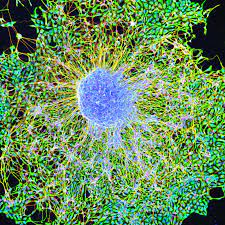 The stem cell theory of aging postulates that the aging process is the result of the inability of various types of stem cells to continue to replenish the tissues of an organism with functional differentiated cells that are capable of maintaining that tissue/organ original function.
The stem cell theory of aging postulates that the aging process is the result of the inability of various types of stem cells to continue to replenish the tissues of an organism with functional differentiated cells that are capable of maintaining that tissue/organ original function.
Stem cells may remain dormant for a persons life, and not fulfill their potential, or differentiate into other cell types and are no longer stem cells.
Stem cells may not differentiate by a process, called self renewal, which allows perpetual generation of cells in a tissue while maintaining a stem cell pool.
The deregulation of self renewal during aging and in response to the microenvironment/microenvironment can lead to cancer and aging.
Damage and error accumulation in genetic material occurs in systems regardless of the age.
The number of stem cells in young people is very much higher than older people and thus creates a better and more efficient replacement mechanism in the young contrary to the old.
Aging is not a matter of the increase in damage, but the failure to replace it due to a decreased number of stem cells.
Stem cells decrease in number and tend to lose the ability to differentiate into progeny lineages.
Damage and error accumulation in genetic material will eventually cause apoptosis.
Different cells may have different lifespans even though they originate from the same stem cells, meaning that aging can occur differently in cells that have longer lifespans as opposed to the ones with shorter lifespans.
The continual effort to replace the somatic cells may cause exhaustion of stem cells.
Stem cells will turn into certain cells as the body needs them.
Stem cells divide more often than non stem cells so the tendency of accumulating damage is greater.
Although they have protective mechanisms, stem cells age and lose function.
Adult tissue stem cells may be the key cell type in the aging process, they may contribute via reducing their differentiation rates, rather than via becoming exhausted.
Heritable epigenetic changes or genetic mutations, have the potential to overwhelm homeostatic regulation of cell numbers when integrity is reduced selection in later life.
Age-dependent accumulation of DNA damage in both stem cells and cells that comprise the stem cell microenvironment is responsible, at least in part, for stem cell dysfunction with aging.
Hematopoietic stem cells (HSCs) regenerate the blood system throughout life and maintain its homeostasis.
DNA strand breaks accumulate in long term HSCs during aging.
and is associated with a broad attenuation of DNA repair and response pathways.
Clonal diversity of stem cells that produce blood cells is reduced around age 70.
Blood cells’ loss of the Y chromosome in a subset of cells, called ‘mosaic loss of chromosome Y’ affects at least 40% of 70 years-old men to some degree, contributes to fibrosis, heart risks, and mortality.
A key aspect of hair loss with age is the aging of the hair follicle’s ability to maintain stem cells associated with each follicle.
The aging of the hair follicle appears to be a cellular response to the DNA damage that accumulates in renewing stem cells during aging.
The DNA damage response involves the proteolysis of type XVII collagen by neutrophil elastase.
However, diseases such as Alzheimer’s disease, end-stage renal failure and heart disease are caused by different mechanisms that are not related to stem cells.
Some diseases related to hematopoietic system, such as aplastic anemia and complete bone marrow failure, are not especially age-dependent.
